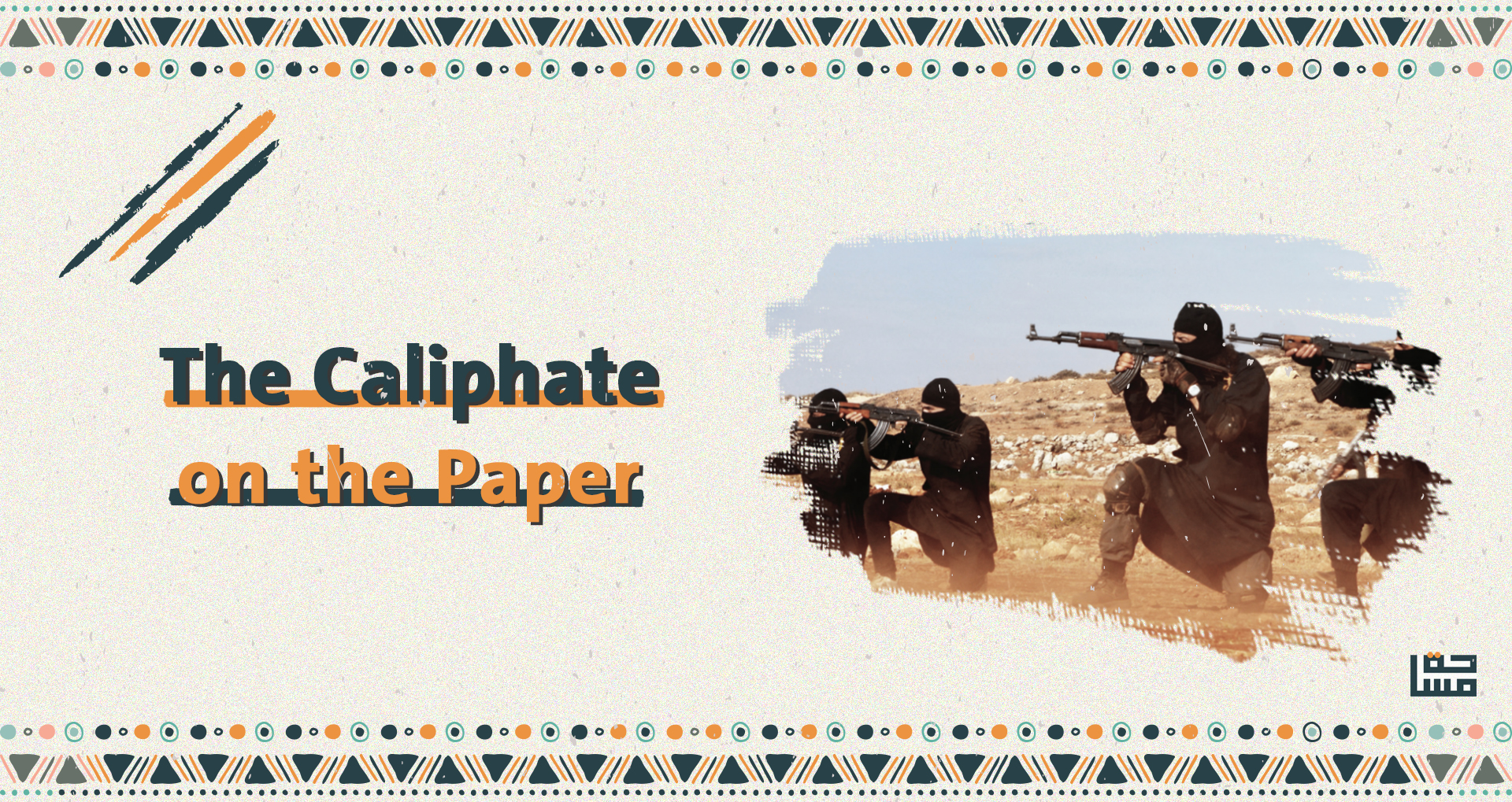The Caliphate on the Paper

A series of writings that tells the stories by a journalist who lived during the days of Islamic State (ISIS) rule, and was arrested as a result of his activities. It is presented to you on Al-Masaha Platform in successive episodes.
The series includes testimonies by the journalist who documented the life of the [ISIS] organization and the internal conflicts among its affiliates, in addition to the conflicts and class differences between the members of the organization itself. These stories also include extensive dialogue about the condition of the population living under the rule of ISIS.
Preface:
In the middle of the year 2014, ISIS controlled the vast majority of the city of Deir ez-Zor. The controlling of the city was very difficult, as the organization launched three campaigns at the beginning of the year 2014; although they were large campaigns, they failed, but what contributed to changing the course of events was the fall of Mosul in Iraq, where ISIS had their hands on the equipment of the Iraqi Army and millions of funds from government institutions. ISIS then mobilized all of their forces towards Deir ez-Zor; the [Syrian] opposition factions, Islamists and tribal fighters collapsed before ISIS’ new military buildup, not to mention other factors that contributed to the fall of the city.
A few days after taking over Deir ez-Zor, the well-known massacre of the Al-Shaitat clan took place at the hands of ISIS elements. The story of the dispute between the organization and Al-Shaitat became famous which we will write about as part of this series. Later on, dozens of executions of ISIS opponents followed, and by 2015 there was a mass exodus of the residents of the Eastern Region as a result of these practices.
A few days after taking over Deir ez-Zor, the well-known massacre of the Al-Shaitat clan took place at the hands of ISIS elements.
ISIS and the Al-Shaitat clan [1]
At the beginning of 2014, ISIS entered Deir ez-Zor governorate and was able to extend its influence over most of the governorate’s towns. This came after fierce battles that took place with the Free [Syrian] Army factions and the rest of the Islamist groups. When ISIS reached the outskirts of the areas where members of Al-Shaitat clan were living, namely the towns of “Al-Kashkiyah, Gharanij and Abu Hamam” – whose population was approximately 150,000 people; ISIS entered the area for Musalaha [reconciliation], at first out of their fear of colliding with a large clan such as the Al-Shaitat. Indeed, ISIS established headquarters to monitor the towns and villages where the clan’s members were present. However, the mentality of ISIS refused [to truly reconcile with the clan], but in order to prevail in their conquest, ISIS tried to impose itself by force on the Al-Shaitat Clan. The first fire was ignited when ISIS members from Maghreb countries killed a young man from Al-Shaitat in his home as a result of a verbal argument. The neighbor of the murdered young man objected and protested against this act, so the neighbor was taken to the market area known as Al-Qahawi Market in the town of Abu Hamam, he was executed by ISIS in public with a knife. The two killings fueled the anger of the people, and Al-Shaitat revolted against ISIS because of the slaughter that had been committed. The outburst of anger was called (Hbbat Al-Shaitat) [Al-Shaitat Uprising], where the members of the clan burned ISIS headquarters and then expelled them from the area. On the other hand, the response of ISIS was insane and unexpected, as it brought in a battalion known at the time as the Mughareba [2] (Al-Battar) Brigade, which consisted of ISIS elements coming from Libya, Tunisia, Algeria and Morocco; this group was considered one of the elite forces of ISIS. The battalion set up cannons and rocket launchers, and besieged the Al-Kashkiyah, Gharanij and Abu Hamam, to begin a series of indiscriminate shelling that led to the killing of dozens of civilians, including women, children and the elderly, without any consideration. Thus, the Al-Shaitat clan had no choice but to defend themselves and their land in the face of the fierce attack of ISIS. Battles erupted that lasted for three consecutive weeks, after which the Al-Shaitat members were able to defeat Al-Battar Brigade and kill dozens of its members. At that point, ISIS was forced to bring ten thousand new fighters from its areas in Iraq, especially from the Anbar region, knowing that the ammunition of the Al-Shaitat clan would run out and the rest of the clans would not assist them. The Al-Shaitat were left alone to face their fate, so most of the Al-Shaitat fighters withdrew towards the Eastern Qalamoun, and only civilians were left inside the towns, thinking that ISIS would not harm them. ISIS invaded the region and committed the most heinous crimes, as all those who were found were killed after a fatwa from the Emir of the organization, called Abu Abdullah Al-Kuwaiti. Al-Kuwaiti had issued a fatwa to kill all of the members of Al-Shaitat, and that their money to be robbed and their population to be displaced from their land. The result of this massacre was that there were about 2,000 dead children under the age of fourteen, old men and women, and the squares of the towns of Al-Kashkiyah, Abu Hamam and Gharanij were filled with dozens of corpses.
The first fire was ignited when ISIS members from Maghreb countries killed a young man from Al-Shaitat in his home as a result of a verbal argument. The neighbor of the murdered young man objected and protested against this act.
Those corpses were thrown on the sidewalks, and dumped in the streams of water and in the desert. The massacre did not stop at that, but all those from the clan were pursued, and chased to a death based on their identity cards. ISIS checkpoints arrested every person from the Al-Shaitat clan. In the town of Mayadin, more than 100 people were arrested, 70 of whom were executed in the desert. About 75 people were executed in Sha’afa area, 150 people were executed in Hajin district, and 170 people in Al-Asharah. In and around the Al-Omar [oil] Field, which is only 20 km away from the Al-Shaitat areas, 500 people were arrested, some of whom were employees of the Al-Omar Field, 300 of them were executed, and the fate of the rest is unknown up until this day. [3]
After these massacres, the people of Al-Shaitat were displaced for a whole year. According to Dr. Ali Al-Alaw, one of the clan’s notables, their property, whose value was estimated at about $500 million, was looted and stolen [by ISIS]. The number of victims of the Al-Shaitat massacre was estimated at more than 200 people, more than 150 of them were under the age of fourteen; the Al-Shaitat clan paid dearly for resisting ISIS. At the same time, the number of ISIS casualties by the Al-Shaitat fighters in the three weeks’ battles was estimated at more than 1,000, in addition to hundreds of ISIS members who were killed by the Al-Shaitat members after the massacre. Some of the Al-Shaitat members later joined Jabhat al-Nusra, another part joined the Syrian government forces, and others joined the Free [Syrian] Army. However, the largest numbers from the Al-Shaitat joined the Syrian Democratic Forces (SDF) and its Special Forces. The Al-Shaitat members [of the SDF] contributed to the expulsion of ISIS from different areas in late 2017, until finally in March 2019 the Baghouz area in Deir ez-Zor, the last stronghold of ISIS in Syria and Iraq, was freed.
The number of victims of the Al-Shaitat massacre was estimated at more than 200 people, more than 150 of them were under the age of fourteen; the Al-Shaitat clan paid dearly for resisting ISIS.
Testimony from an Al-Shaitat clan member:
The following is the testimony of one of the members of Al-Shaitat. He narrates the events as they happened:
“The beginning of the first clash between ISIS and Al-Shaitat members in Deir ez-Zor, was after the agreement concluded at the time between the Free [Syrian] Army factions that were fighting ISIS and ISIS itself. The agreement specified that the members of the Free [Syrian] Army were asked to hand over their weapons to ISIS, in exchange for their safe exit from the entire region. Of course, the agreement at the time required that ISIS would not move its military headquarters into the villages and towns of Al-Shaitat clan including Abu Hamam, Al-Kashkiyah, Gharanij. The Free [Syrian] Army implemented the agreement, handed over their military equipment [to ISIS], and all the FSA fighters went to the Eastern Qalamoun.
ISIS initially made the Al-Kashkiyah municipality its headquarters, and that was five days before the month of Ramadan. On the fifteenth day of the month of Ramadan, ISIS elements began to impose restrictions on the people, for example: “You are a young man walking in the street and smoking”, or “why is your lower garment long and not shortened?” They [ISIS] also flogged some young men, and of course until then there was no reaction from the Al-Shaitat members at all. However, on the last day of Eid al-Fitr, ISIS elements entered, at about 7-8 in the morning, a house in the village of Abu Hamam, and they slaughtered the owner of the house before the eyes of his wife and children; the slaughter was based on personal revenge. After ISIS members committed the killing, the wife rushed to the street, asking for help. A group of young men came out to face ISIS elements and resisted them because of the woman. The young men immediately headed towards the headquarters of ISIS located in the town of Al-Kashkiyah, and captured a number of them, most of whom were foreigners; they were not Syrians, not even Arabs. About three or four members of ISIS were killed, and in the meantime, the people burned the [ISIS] headquarters. In response, ISIS arrested about 52 young men from Al-Shaitat clan who worked in the oil fields with ISIS. Two days later, negotiations took place for prisoner exchange, and after the third day of this agreement, ISIS handed over 52 detainees, but how were they released?! ISIS had published a post on social media platforms, showing the prisoners as they were beheaded after being sentenced to death. That was when the spark ignited, and as a reaction from the Al-Shaitat, they killed the ISIS prisoners who they were keeping. This was the beginning of the first clash between the two parties.
In the fighting that lasted about 15-17 days, Al-Shaitat lost about 9 people, and the total number of casualties exceeded 1,000 people; these people were killed after ISIS had initially granted them safety, meaning that the people who had nothing to do with the Al-Shaitat were planned to leave the area. ISIS in fact cleared the road from Gharanij through Al-Bahra to the end of the eastern countryside, Al-Baghouz, Al-Sha’fa, Hajin and other areas. Yet ISIS carried out random arrest campaigns, which were conducted after the people were initially given safety, and the ISIS elements began raiding homes and arresting anyone according to their identity card and birth certificate. If it was written on their ID cards that the person was from Al-Kashkiyah, Gharanij or Abu Hamam, they were arrested and executed directly, or slaughtered with a knife without any trial or charge. The given accusation was “fighting the Islamic State, God and the Messenger of God, and that this clan is considered an apostate.”
ISIS carried out random arrest campaigns, which were conducted after the people were initially given safety, and the ISIS elements began raiding homes and arresting anyone according to their identity card and birth certificate.
The material losses of this massacre were truly incalculable. If we talk about shops, there were foodstuffs that were entirely stolen, and if we talk about homes, then there were furniture and gold that were robbed, and if we talk about livestock, they were also completely taken.
Al-Shaitat organized their fighting ranks against ISIS without any prior arrangement or coordination; as mentioned earlier, the men of Al-Shaitat stood against ISIS to help the woman. Even during the battle, the main fighters who were fighting ISIS did not possess heavy weapons because they were not available in the area. Yet, the Free [Syrian] Army had surrendered their heavy weapons [to ISIS] and headed towards the Eastern Qalamoun under an agreement with ISIS.
The displacement of Al-Shaitat clan:
After the battle continued, ISIS offered safety and promises, such as its promise that any person or family unrelated to the fight or fighters would exit safely. In fact, many people went out with only their clothes, and they left all their belongings behind. Yet everyone was treated in the same way, the fighters and civilians, they were persecuted for bearing “apostasy”. Therefore, most of the people fled and headed to different areas. A section headed towards the areas controlled by the Syrian regime, while another headed towards Idlib, others joined the Eastern Qalamoun, and some left towards Turkey – until no one was left in the area except for a small number of young men from the of Al-Shaitat. This displacement was because of ISIS’ record of killing any person based on their identity and birth in the Al-Kashkiyah or Gharanij areas.
A section headed towards the areas controlled by the Syrian regime, while another headed towards Idlib, others joined the Eastern Qalamoun, and some left towards Turkey – until no one was left in the area except for a small number of young men from the of Al-Shaitat.
At the launch of the military campaign against ISIS, that was, early 2017, the Al-Shaitat men organized themselves, and many of them joined the Syrian Democratic Forces (SDF), and participated in the military campaign to liberate the city of Deir ez-Zor. This was after four years of displacement and the horrific massacres committed by ISIS against the Al-Shaitat.
In the next series you will read:
The conflicting factions within ISIS, and the differences that were emerging between them.
References:
1 – The Sunni Al-Shaitat clan numbered approximately 200,000 people, and they are from the branches of Al-Aqidat [or Al-Akidat], and most of its young men joined the Free [Syrian] Army. The tribe did not acquiesce to ISIS at first, as ISIS sought to impose its control first and then restrict the oil for itself. The Tanak oil field is located in the Al-Shaitat desert, which is the second largest oil field in the region after the Al-Omar field. (Writer).
2 – The term refers to ISIS members coming from the Maghreb countries.
3 – The above statistic is according to what Dr. Ali Al-Alaw, one of the notables of the Al-Shaitat clan, has said, and based on the testimonies of local activists. (Writer).




